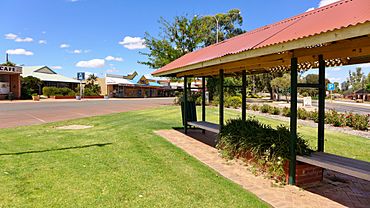Wongan Hills, Western Australia facts for kids
Quick facts for kids Wongan HillsWestern Australia |
|||||||||
|---|---|---|---|---|---|---|---|---|---|

View of Fenton Place, Wongan Hills, 2016
|
|||||||||
| Established | 1911 | ||||||||
| Postcode(s) | 6603 | ||||||||
| Elevation | 286 m (938 ft) | ||||||||
| Area | [convert: needs a number] | ||||||||
| Location | 182 km (113 mi) NNE of Perth | ||||||||
| LGA(s) | Shire of Wongan-Ballidu | ||||||||
| State electorate(s) | Moore | ||||||||
| Federal Division(s) | Durack | ||||||||
|
|||||||||
Wongan Hills is a cool town located in the Wheatbelt region of Western Australia. It's about 182 kilometers (113 miles) north of Perth, the state capital. The town sits at an elevation of 286 meters (938 feet) above sea level.
The town gets its name from a group of hills nearby, also called Wongan Hills. These hills were first noted in 1836 by John Septimus Roe, who was a surveyor.
Contents
Discovering Wongan Hills: A Look at Its Past
Wongan Hills has a fascinating history, starting from its early days as a settlement.
How Wongan Hills Got Its Name
People started settling in the Wongan Hills area in the early 1900s. In 1911, the town was officially named. It was named after the nearby hills. The name "Wongan" comes from an Indigenous Australian word, possibly "wangan-katta." "Katta" means "hill," but the meaning of "wongan" is a bit of a mystery. It might mean "sandplain" or even "whispering." So, "Wongan Hills" could mean "whispering hills"!
Famous People and Early Life
In the early 1900s, a poet named Lilian Wooster Greaves lived in Wongan Hills with her family. She wrote poems and stories about what life was like there, especially during World War I. Her writings give us a peek into the past of this area.
The Arrival of the Railway
The railway played a big part in the growth of Wongan Hills. In 1911, a railway line from Goomalling reached the town. This made it easier to transport goods and people. The railway line was later extended in 1915, connecting Wongan Hills even further.
Farming and Research
Farming is very important to Wongan Hills. In 1925, an agricultural research station was set up just north of the town. This station helped local farmers learn new and better ways to grow crops and raise animals. Today, the area is known for its successful farms, especially for sheep, grain, and pigs.
In 1933, a large building called a grain silo was built. This was part of a big plan to help farmers store and move their grain more easily. It was managed by a group called Cooperative Bulk Handling.
Unique Easter Celebrations
In 2009, Wongan Hills had a very special Easter celebration. Farmers used 460 half-tonne hay bales to create a giant cross in a field. The cross was huge, about 1.8 kilometers (1.1 miles) long! They used GPS to make sure it was perfectly shaped. On Good Friday night, the cross was lit up, creating an amazing sight.
Understanding the Climate of Wongan Hills
Wongan Hills has a unique climate that has changed over time.
What Kind of Climate Does Wongan Hills Have?
Historically, Wongan Hills had a Mediterranean climate (like parts of southern Europe). This means it had hot, dry summers and mild, wet winters. However, in recent times, the climate has become drier. It is now considered a hot semi-arid climate. This type of climate has very hot and dry summers, but winters are still comfortable with cool nights. Sometimes, big storms called tropical cyclones from the Indian Ocean can bring rain to the area.
| Climate data for Wongan Hills | |||||||||||||
|---|---|---|---|---|---|---|---|---|---|---|---|---|---|
| Month | Jan | Feb | Mar | Apr | May | Jun | Jul | Aug | Sep | Oct | Nov | Dec | Year |
| Record high °C (°F) | 47.4 (117.3) |
47.0 (116.6) |
43.5 (110.3) |
39.2 (102.6) |
34.7 (94.5) |
27.5 (81.5) |
25.4 (77.7) |
30.2 (86.4) |
35.2 (95.4) |
39.5 (103.1) |
42.0 (107.6) |
45.0 (113.0) |
47.4 (117.3) |
| Mean daily maximum °C (°F) | 34.6 (94.3) |
34.1 (93.4) |
30.9 (87.6) |
26.4 (79.5) |
21.5 (70.7) |
18.2 (64.8) |
17.0 (62.6) |
17.9 (64.2) |
20.7 (69.3) |
25.2 (77.4) |
29.2 (84.6) |
32.5 (90.5) |
25.7 (78.3) |
| Daily mean °C (°F) | 26.3 (79.3) |
26.2 (79.2) |
23.7 (74.7) |
19.9 (67.8) |
15.7 (60.3) |
13.0 (55.4) |
11.8 (53.2) |
12.3 (54.1) |
14.2 (57.6) |
17.7 (63.9) |
21.2 (70.2) |
24.2 (75.6) |
18.9 (66.0) |
| Mean daily minimum °C (°F) | 17.9 (64.2) |
18.2 (64.8) |
16.4 (61.5) |
13.4 (56.1) |
9.9 (49.8) |
7.7 (45.9) |
6.6 (43.9) |
6.7 (44.1) |
7.6 (45.7) |
10.1 (50.2) |
13.2 (55.8) |
15.8 (60.4) |
12.0 (53.6) |
| Record low °C (°F) | 9.8 (49.6) |
8.5 (47.3) |
5.5 (41.9) |
2.8 (37.0) |
−0.6 (30.9) |
−0.8 (30.6) |
−0.9 (30.4) |
−0.5 (31.1) |
0.5 (32.9) |
0.5 (32.9) |
3.4 (38.1) |
7.3 (45.1) |
−0.9 (30.4) |
| Average precipitation mm (inches) | 15.5 (0.61) |
15.5 (0.61) |
20.8 (0.82) |
22.6 (0.89) |
51.8 (2.04) |
69.5 (2.74) |
69.3 (2.73) |
51.6 (2.03) |
29.8 (1.17) |
19.6 (0.77) |
12.4 (0.49) |
10.0 (0.39) |
388.2 (15.28) |
| Average precipitation days | 2.1 | 2.3 | 2.9 | 4.9 | 8.9 | 12.3 | 13.5 | 12.2 | 8.6 | 5.9 | 3.4 | 2.0 | 79.0 |
| Average relative humidity (%) | 24 | 28 | 31 | 38 | 48 | 56 | 58 | 55 | 47 | 34 | 28 | 26 | 39 |
Images for kids



